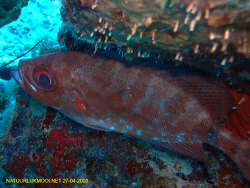Info
(Lacepède, 1801)
Distribution:
Circumglobal in tropical and tropically influenced seas. Western Atlantic: continental waters from off Florida to Flower Garden Reef off Texas in the Gulf of Mexico; Caribbean islands and along the coast of South America to Argentina. Eastern Atlantic: eastern and mid Atlantic islands from Madeira to St. Helena; not recorded from African continental waters. Indo-Pacific: South and eastern Africa (excluding the Red Sea) eastward in island habitats through the central Pacific. Eastern Pacific: island habitats from off Baja California to the Galapagos; probably uncommon along coast of Mexico, Central and South America, questionably to Chile.
Biology:
Common in lagoon and seaward reefs, primarily around islands. Under or near ledges by day.
Benthopelagic. Juvenile pelagic. Nocturnal, feeding mainly on octopi, pelagic shrimp, stomatopods, crabs, small fish, and polychaetes.
Solitary. During the day usually occurs singly or in small groups but at dusk it may gather in large numbers. Known to produce sound.
Reports of ciguatera poisoning!
Synomised taxa:
Anthias boops Forster, 1801
Cookeolus boops (Forster, 1801)
Labrus cruentatus Lacepède, 1801
Priacanthus argenteus Cuvier, 1829
Priacanthus bleekeri Castelnau, 1873
Priacanthus bonariensis Cuvier, 1829
Priacanthus boops (Forster, 1801)
Priacanthus carolinus Cuvier, 1829
Priacanthus cepedianus Desmarest, 1823
Priacanthus cruentatus (Lacepède, 1801)
Priacanthus fulgens Lowe, 1838 (synonym)
Serranus rufus Bowdich, 1825
Distribution:
Circumglobal in tropical and tropically influenced seas. Western Atlantic: continental waters from off Florida to Flower Garden Reef off Texas in the Gulf of Mexico; Caribbean islands and along the coast of South America to Argentina. Eastern Atlantic: eastern and mid Atlantic islands from Madeira to St. Helena; not recorded from African continental waters. Indo-Pacific: South and eastern Africa (excluding the Red Sea) eastward in island habitats through the central Pacific. Eastern Pacific: island habitats from off Baja California to the Galapagos; probably uncommon along coast of Mexico, Central and South America, questionably to Chile.
Biology:
Common in lagoon and seaward reefs, primarily around islands. Under or near ledges by day.
Benthopelagic. Juvenile pelagic. Nocturnal, feeding mainly on octopi, pelagic shrimp, stomatopods, crabs, small fish, and polychaetes.
Solitary. During the day usually occurs singly or in small groups but at dusk it may gather in large numbers. Known to produce sound.
Reports of ciguatera poisoning!
Synomised taxa:
Anthias boops Forster, 1801
Cookeolus boops (Forster, 1801)
Labrus cruentatus Lacepède, 1801
Priacanthus argenteus Cuvier, 1829
Priacanthus bleekeri Castelnau, 1873
Priacanthus bonariensis Cuvier, 1829
Priacanthus boops (Forster, 1801)
Priacanthus carolinus Cuvier, 1829
Priacanthus cepedianus Desmarest, 1823
Priacanthus cruentatus (Lacepède, 1801)
Priacanthus fulgens Lowe, 1838 (synonym)
Serranus rufus Bowdich, 1825







 Kevin Bryant, USA
Kevin Bryant, USA












